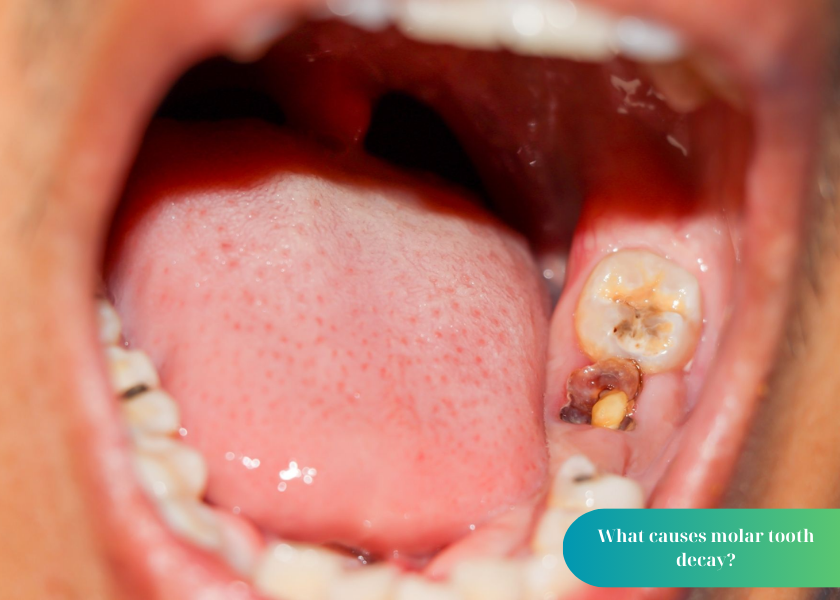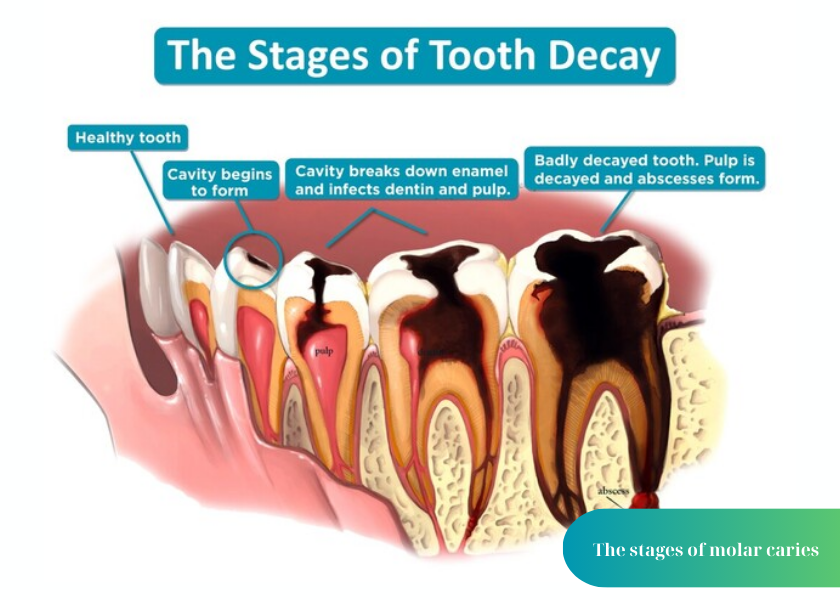What causes molar tooth decay?: Molars, also known as teeth number 6, 7 and 8, have the main function of chewing and crushing food. If molars are not brushed cleanly, the risk of tooth decay is very high. This is a common oral disease that can affect all ages, from children to adults. Molar tooth decay is a serious condition that can lead to permanent tooth loss.
To treat and prevent molar tooth decay, please follow the article below by BeamDental to have full information related to this issue!
Tư vấn chuyên môn bài viết:
BÁC SĨ DƯƠNG THỊ THÙY NGA
What is molar tooth decay?
Molars include both large and small molars, from teeth number 4 to tooth number 8. An adult will have a total of 20 molars. Of these, teeth number 6 and number 7 are the two most important teeth, because if they are decayed and damaged, they will not be able to grow back on their own like baby teeth.
Molar cavities occur when large amounts of plaque build up on the teeth, creating small holes in the tooth and dentin. This condition is common in children and the elderly, but young children are also at risk for molar cavities. If left untreated, molar cavities can spread to the roots and between the teeth, leading to tooth loss and complete tooth loss.
See more: 12 safe and effective ways to treat tooth decay at home
What causes molar tooth decay?

There are many causes of tooth decay, most of which stem from our daily habits:
Improper dental care
- Poor oral hygiene: If you don’t brush your teeth properly or regularly, bacteria can build up and cause tooth decay.
Lack of calcium and fluoride
- Lack of calcium: A diet lacking in calcium weakens tooth enamel, making it more susceptible to wear and tear.
- Lack of fluoride: Fluoride helps prevent tooth decay. If you don’t use toothpaste or mouthwash containing fluoride, your teeth are at risk of decay.
Eating foods that are too hot, too cold, or contain sugar
- Foods that are too hot or cold: Eating foods that are extremely hot or high in sugar, such as ice cream, yogurt, candy, and cookies, can create a favorable environment for bacteria and acids to damage tooth enamel.
Dry mouth
- Lack of saliva: Saliva helps soften food and prevent acids from bacteria. Dry mouth reduces this protection, leading to tooth decay.
Fillings
- Dental fillings: Over time, fillings can chip or crack, allowing bacteria and plaque to grow, causing cavities in molars.
Heartburn
- Gastroesophageal reflux: Acid from the stomach can flow back into the mouth, damaging tooth enamel and causing cavities.
Digestive disorders
- Digestive problems: Vomiting or acid reflux releases acid that can damage tooth enamel, leading to cavities.
Age
- Older adults: Teeth and gums can age, and medications used to treat age-related conditions can cause bad breath and increase the risk of cavities in molars.
The stages of molar caries

Molar decay develops in four main stages:
Stage 1: Plaque formation
The first indication of tooth decay manifests as the formation of dental plaque. Plaque typically appears as a sticky, colorless or slightly colored film on the teeth, ranging in shades from green to yellow or opaque white. This substance forms when sugars and starches from food remain on the tooth surfaces and are not adequately cleaned away. The bacteria naturally present in the mouth thrive on these food particles, feeding on the plaque, which begins the process of tooth decay.
Stage 2: Enamel destruction
As plaque continues to accumulate on the tooth surfaces, it produces acids that gradually erode the tooth’s outer protective layer, known as the enamel. The enamel is the hardest substance in the human body, but it is not impervious to the persistent attack from these acids. Over time, as the enamel weakens and breaks down, bacteria can penetrate deeper into the tooth, reaching the softer dentin layer beneath. The dentin is much thinner and less resistant than enamel, making it more vulnerable to bacterial invasion. As bacteria reach this layer, they can cause increased sensitivity and pain due to the proximity of the dentin to the tooth’s nerve endings.
Stage 3: Inner tooth damage
If the decay process is not halted, bacteria will continue to advance beyond the dentin, reaching the innermost part of the tooth, known as the pulp. The pulp is the living tissue within the tooth, containing nerves, blood vessels, and connective tissue. When bacteria invade the pulp, they can cause significant damage, leading to inflammation and infection. This stage of decay can be extremely painful, as the infection may produce pus and lead to swelling, not just within the tooth but potentially affecting the surrounding facial tissues as well. The pain often radiates outward from the infected tooth, becoming more intense and widespread.
Stage 4: Infection and tooth loss
In the most severe cases, if the bacterial infection is left untreated, it can spread to the apex of the tooth, where the roots and many nerve endings are located. This stage of infection can cause severe pain and swelling, and it may lead to complications that impact both the functionality and appearance of the tooth. The infection may also spread to surrounding tissues, leading to abscesses and further complications. If the damage is too extensive and cannot be reversed, extraction of the tooth may become necessary to prevent the infection from spreading further and to alleviate the pain and discomfort associated with the condition.
See more: 6+ effective ways to treat tooth decay
Symptoms of tooth decay

When you have a cavity in your molars, you may experience the following symptoms:
- Pain: Aching is a common sign. Sometimes, the pain can spread to the eyes or jaws and last continuously.
- Sensitivity: Your teeth may be numb and sensitive when you eat or drink food that is too hot or too cold.
- Bad breath: There may be a bad smell from your mouth, accompanied by a bitter taste in your throat.
- Change in tooth color: Your teeth may have black or brown spots, or turn yellow.
See more: Experience in identifying types of dental bridges and 7+ things you need to know
Some effective treatments for molar cavities
Depending on the severity of the cavity, there will be different treatments such as:
Treatment of mildly decayed molars
When the molars have just grown in and do not interfere with daily activities or study, your dentist may recommend a filling to fill the cavities. Fillings help restore the shape and function of the teeth using materials such as rubber, composite resin, or metal.
Depending on the condition of the tooth decay, the doctor may prescribe the following tooth filling methods:

- Inlay: The inlay technique is specifically designed to treat cavities that are located within the central portion of a tooth, typically on the biting surface. This method is ideal for situations where the decay or damage is confined to the interior of the tooth and has not extended to the surrounding areas or the edges. Inlays are custom-made from materials such as composite resin, porcelain, or gold, and they are precisely crafted to fit the cavity. Once prepared, the inlay is securely bonded into the cavity, effectively restoring the tooth’s structure and function without impacting the surrounding healthy tooth tissue.
- Onlay: When a cavity is more extensive, affecting not just the central area of the tooth but also spreading to the cusps or the chewing surfaces, an onlay is a more suitable treatment option. Onlays are used in cases where the decay or damage extends beyond the central area but does not require a full crown. Like inlays, onlays are custom-made from durable materials, but they cover a larger portion of the tooth, including one or more of its cusps. This approach allows for the preservation of more of the natural tooth structure while providing a strong, long-lasting solution that restores both the appearance and function of the tooth.
- Overlay: The overlay technique is employed when a tooth has suffered significant damage, such as the loss of a substantial portion of the tooth crown, often up to half or more. Overlays are a more extensive type of restoration, designed to cover the entire chewing surface of the tooth, including the damaged or missing portions of the crown. This method is typically chosen for teeth that are severely compromised, providing a durable solution that not only protects the remaining tooth structure but also restores its full functionality and aesthetic appearance. Overlays are custom-made to fit precisely over the damaged tooth, offering a comprehensive restoration that helps to prevent further deterioration while ensuring the tooth can continue to perform effectively in daily use.
Treatment of deep molar cavities that have reached the pulp
When the pulp is damaged, conventional treatments cannot completely resolve the cavity. Here are the necessary treatment options:

- Root canal treatment: If the pulp is damaged, you will feel prolonged pain and may be accompanied by headaches. Root canal treatment is an important step to prevent the cavity from spreading and to relieve pain. If not treated promptly, the condition can become more serious, leading to tooth fracture or loss.
- Porcelain crowns: After root canal treatment, if the cavity is too large to be filled, porcelain crowns are an effective restoration solution. This method helps protect and restore the function of the tooth, although the cost may be higher.
- Tooth extraction: If the pulp is severely infected and cannot be treated, the dentist may recommend tooth extraction. The infection can spread to areas such as the maxillary sinus or eye, causing serious complications. After tooth extraction, you will need to consider replacing the tooth with a denture to keep the jaw bone healthy.
Early treatment of molar tooth decay will help avoid serious complications. However, you should choose a reputable dental facility and a highly qualified doctor to ensure the quality of treatment. If you have any questions about oral health, please contact BeamDental via hotline for detailed advice. BeamDental with many years of experience in the dental industry is committed to providing top quality dental care services.
Hopefully the useful information in the above article has helped you answer questions about the cause of molar tooth decay and treatment methods.
See more: Why do children get tooth decay from eating candy? and 5 solutions
BEAMDENTAL – HỆ THỐNG NHA KHOA TIÊU CHUẨN HÀNG ĐẦU
CHI NHÁNH HÀ NỘI
CS1: 7B Thi Sách, Ngô Thì Nhậm, Hai Bà Trưng, Hà Nội - 0934.61.9090
CS2: 98C Chiến Thắng, Văn Quán, Hà Đông - 0934.61.9090
CHI NHÁNH TP.HỒ CHÍ MINH (HCM)
56 Nguyễn Đình Chiểu, Đa Kao, Quận 1, Tp.Hồ Chí Minh - 0766.00.8080
GIỜ HOẠT ĐỘNG:
09h00 – 21h00. Tất cả các ngày trong tuần
Link web: beamdental.com.vn



